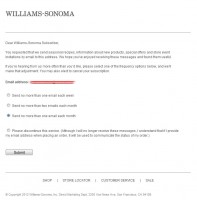It’s no secret that marketing and development email blast overload is a real problem for this business. If you need an idea about how much negative blow-back is bouncing around out there check out some Yelp reviews of orchestras (there are a few good ones featured here).

You’ll begin to notice the trend of complaints coming from newbies griping about the onslaught of calls and mailings following their newbie concert experience.
And even though a large part of my consulting business is trying to help arts groups sell their offerings through every available tool, I completely sympathize with these sorts of patron complaints. I certainly hate it when after buying something from a retailer’s online store, my inbox gets flooded with newsletters.
Sure, most sites provide an opt-out of communication when making purchases but I don’t always want such a definitive option; I do want to hear about future specials etc. I just don’t want to get buried by them.
Case in point, I recently purchased a set of measuring cups from Williams-Sonoma’s online store as a Christmas present for my wife and the very day of the purchase, I started getting between two and four email messages a day. I recall skipping over the opt-out when making the purchase (mostly because I was in a hurry) and the messages were really starting to piss me off.
Some were enormous, image laden beasts that didn’t play very nice with my iPad email client and would trigger my desktop email client’s “compacting” threshold, consequently delaying the download of other messages.

So enough was enough, I clicked the unsubscribe link and was taken to the corresponding page which provided a few options besides discontinuing entirely. Clearly, the folks running the email blasts knew they were playing fast and loose when it comes to overloading list members so they came up with a few additional options to throttle back on messages; one per week, two per month, or one per month.
Although anyone remotely connected to marketing knows this isn’t a new approach, it still surprises me how infrequently I see it in orchestra customer relationship management. I’ve seen plenty of unsubscribe surveys (beyond the atypical “tell us why you’re leaving” paragraph field) which always come across as [sws_css_tooltip position=”center” colorscheme=”rosewood” width=”450″ url=”” trigger=”insult to injury” fontSize=”14″]Gee, we’re sorry we pummeled you with email messages, but would you mind if we took a little more of your time by telling us why you’re unsubscribing? [/sws_css_tooltip] more than anything else; it is very “What can you do for us?” oriented behavior.
And after thinking about it for a few days now, I can’t recall a single marketing study or white paper focused exclusively on the orchestra field which addresses this issue through some solid case examples. If anyone is aware of something, please post a comment with a link (if applicable).
Likewise, I’m sure everyone would love to hear from orchestra marketing folks about how they address this topic. Do you offer user defined contact frequency options through user accounts in your box office and/or CRM solution or at the direct point of purchase? Do your email unsubscribe/opt-out pages include message throttling?


